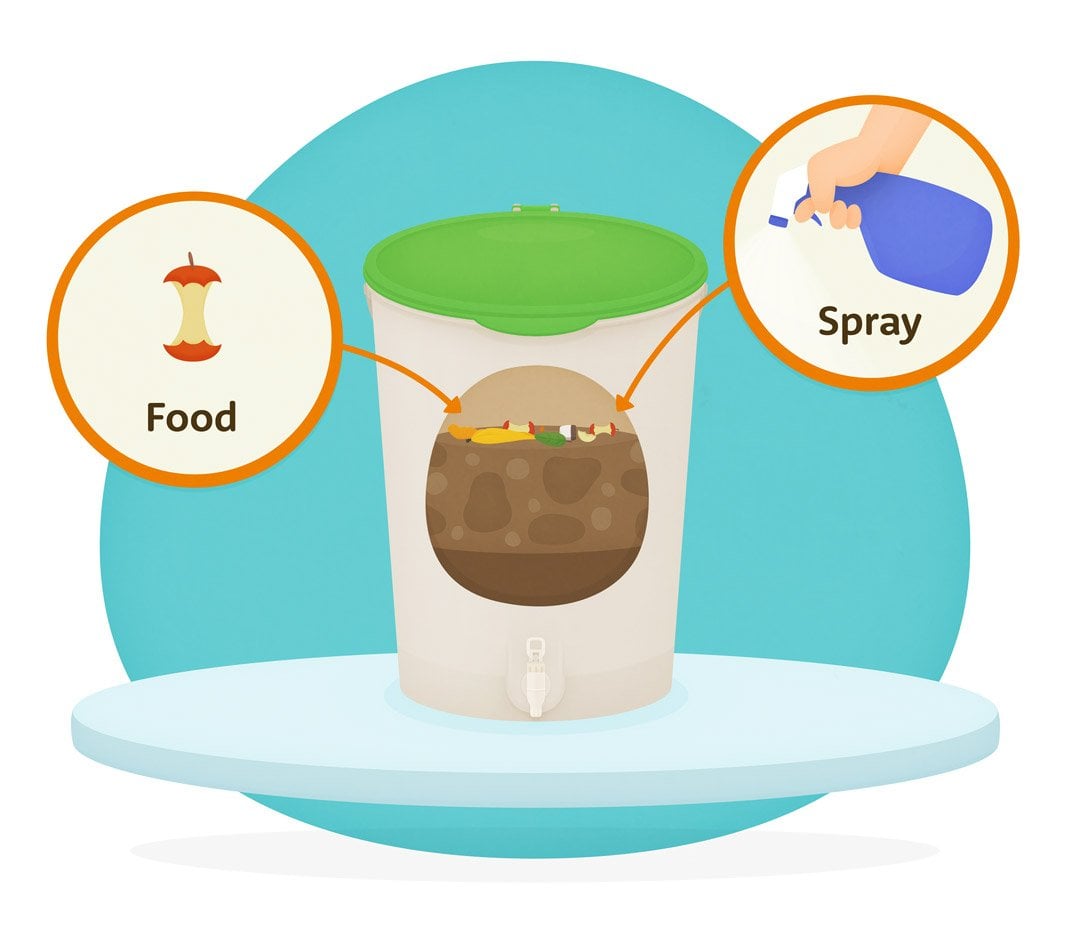Chọn một phương pháp
Choose whether a compost bin, worm farm, or bokashi bin is right for you based on your volume and type of food/garden waste, available space, and budget.
If you would like help choosing your product, click on the chat bot button right and select Send Message.

The different composting systems all accelerate nature's natural processes by heating up the compost and concentrating the microbes into a confined space.
Composting systems vary in what they recycle, including all types of organic waste such as food, paper, cardboard and garden materials. They all process larger volumes, making them suitable for households with a lot of food and/or garden waste.
Traditional (also known as above ground) compost bins need to be placed on soil. As the scraps break down, nutrient-rich liquid will disperse into the surrounding soil leaving rich compost to be harvested from the bottom every 6-12 months. They require regular (twice weekly) turning with an aerator.
Tumbling composters sit off the ground and can be placed anywhere, including balconies. The liquid from this process drips out and can be harvested or allowed to soak into the ground below. They require regular rotation with a hand crank or by rotating the drum directly, and produce rich compost in around 3-6 months (a little faster than traditional systems).
Solar composters are partially dug into the ground and capture more heat from the sun which aerates the compost without the need to turn it. So, they are faster than the other two systems and require less maintenance. They do not compost garden organics but do process all kinds of food waste and even pet poo!
Nhận giảm giá của quý vị

Works by accelerating nature’s natural process of breaking down organic waste into a rich nourishing compost, teeming with life and a supercharger for your garden.
Composting systems recycle all types of organic waste including food, paper, cardboard and garden materials. This makes them perfect for larger households.
Open-bottom units need to be placed on soil. As the scraps break down nutrient-rich liquid will disperse into the surrounding soil. After ~6 months compost can be harvested from the bottom.
Nhận giảm giá của quý vị

Works by aerobic decomposition, using the sun’s energy to break down food scraps into nutrients that are dispersed by worms and leaching liquids, which nourishes the surrounding soil.
Zero waste. Zero maintenance. Solar boosted composter.
The Green Cone recycles all types of food waste (including meat, dairy, bread and small bones) as well as small amounts of pet poo (not recommended if it is installed near food crops!). Designed to naturally circulate oxygen, there is no need for regular aeration making it perfect for medium to large households looking for a low-maintenance solution.
The system needs to be buried in well-draining soil, with full sun exposure for most of the day. As the food scraps break down, nutrient-rich liquid will disperse into the surrounding soil. No harvestable compost is produced.
Nhận giảm giá của quý vị

Works by accelerating nature’s natural process of breaking down organic waste into a rich nourishing compost, teeming with life and a supercharger for your garden.
Composting systems recycle all types of organic waste including food, paper, cardboard and garden materials. This makes them perfect for larger households.
Tumblers sit off the ground and can be placed anywhere, including balconies. As the scraps break down nutrient-rich liquid will drain from the tumbler and can be collected to fertilise your garden. After one chamber is full you can let the compost mature whilst filling the other. After ~6 months you can harvest the mature compost.
Nhận giảm giá của quý vị

Works with the help of wriggly warriors who chew through your food scraps, producing nutrient-rich worm castings and liquid fertiliser.
Worm farms recycle fruit and vegetables scraps, excluding citrus, onion, garlic and chilli.
The units can be placed indoors or outdoors, in a sheltered location out of the wind, rain and direct sunlight.
With a little tender loving care, worms will chew through your food scraps to produce nutrient-rich worm castings which can be harvested every 2-6 months. Liquid fertiliser also flows out of the farm on a regular basis, which can be diluted 10 to 1 with water to create free organic fertiliser for your garden.
Choose from the Farm, our compact, stylish award-winning worm farm made here by the Compost Revolution in Melbourne, Australia, or the large capacity Hungry Bin, made in New Zealand and ready to much through 2L of good a day!
Nhận giảm giá của quý vị

A special culture of beneficial, naturally occurring microorganisms (EM) ferment food waste in anaerobic conditions, producing liquid fertiliser and fermented scraps.
Bokashi systems ferment all types of food waste (including meat, dairy, bread and small bones). The unit can be placed indoors or outdoors, in a cool location.
Food waste is added then mashed down to remove air pockets, followed by a spray of enzyme or handful of enzyme grain. Effective microorganisms (EM) then ferment food waste in anaerobic conditions.
Liquid fertiliser needs to be tapped every few days. Once the unit is full, the scraps are left to ferment for 1-2 weeks before being added to a compost bin or buried in soil. Fermented scraps will break down in 2-3 weeks in the soil delivering rich nutrients to surrounding plants.
Nhận giảm giá của quý vị
Compost bins retain heat to speed up the process via above ground, partially buried, or rotating chambers.
- Processes lots of food scraps (limit meat and diary).
- Above ground and tumblers compost garden waste too.
- Low maintenance.
Produces rich harvestable compost for your garden and the sourrounding soil, plus tumblers produce liquid fertiliser.
See benefits
Những con trùng/giun trong thùng nuôi trùng/giun sẽ phân hủy thực phẩm thải bỏ bằng cách ăn các vi sinh vật ăn thức ăn của quý vị. Thùng nuôi trùng/giun hoạt động tốt cho người cư ngụ trong căn hộ và trẻ em rất thích. Quý vị cần phải có vị trí có mái che để đặt thùng nuôi trùng/giun và không thể giải quyết nhiều vật liệu như thùng làm phân xanh (compost bin). Các loại vật liệu quý vị có thể bỏ vào thùng nuôi trùng/giun (worm farm) cũng hạn chế hơn so với thùng làm phân xanh (compost bin).
Chọn thùng nuôi trùng/giun (worm farm) nếu quý vị:
- không thường xuyên có nhiều cây cành
- cư ngụ trong căn hộ hoặc không có chỗ trống trên mặt đất, cát, sỏi để đặt thùng làm phân xanh
- gia đình ít người (dưới 4 người) hoặc quý vị không thải bỏ nhiều thực phẩm
Những lợi ích của thùng nuôi trùng/giun (worm farm) là:
- phân bón lỏng (là sản phẩm chính) từ thùng nuôi trùng/giun (worm farm) của quý vị dễ sử dụng cho khu vườn của quý vị
- quý vị có thể đặt thùng nuôi trùng/giun trong sân, trên ban-công hoặc trong nhà
See benefits
Phương pháp làm phân xanh Bokashi sử dụng biện pháp lên men để ủ thức ăn thải bỏ trong một thùng kín hơi. Rác thải sẽ phân hủy mà không có mùi khó chịu hoặc thu hút côn trùng. Phương pháp này rất phù hợp với các hộ gia đình nhỏ với không gian hạn chế.
Phương pháp làm phân xanh Bokashi là phù hợp nếu quý vị:
- sống trong một căn hộ
- làm việc trong một văn phòng có bếp ăn
- có chỗ để sau đó chôn hoặc làm loại phân bón bán rắn (một mảnh vườn trồng rau, thùng làm phân xanh hoặc một khu vườn cộng đồng)
Một vài trong số nhiều lợi ích của phương pháp này là:
- Nếu nó không có mùi, quý vị có thể để nó trong bếp
- Nó có thể xử lý được thịt, sản phẩm bơ sữa,các giống cam quýt, và hành; đây là những thứ mà trùng/giun không thích
- phân bón dạng lỏng rất dễ thu hoạch
See benefits











